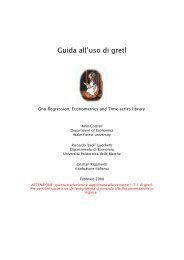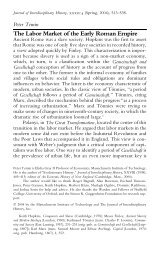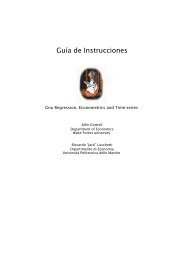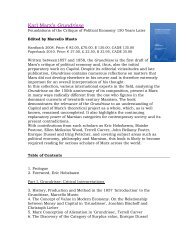How did Paul Krugman get it so Wrong? John H. Cochrane ...
How did Paul Krugman get it so Wrong? John H. Cochrane ...
How did Paul Krugman get it so Wrong? John H. Cochrane ...
Create successful ePaper yourself
Turn your PDF publications into a flip-book with our unique Google optimized e-Paper software.
<strong>so</strong> on. They’ve thought about why there is <strong>so</strong> much short term debt, why banks run,<br />
how depos<strong>it</strong> insurance and cred<strong>it</strong> guarantees help, and how they give incentives for<br />
excessive risk taking.<br />
If we want to think about events and policies, this seems like more than a minor detail.<br />
The hard and central policy debate over the last year was how to manage this financial<br />
crisis. Now <strong>it</strong> is how to set up the incentives of banks and other financial inst<strong>it</strong>utions<br />
<strong>so</strong> this mess doesn’t happen again. There’s lots of good and subtle economics here<br />
that New York Times readers might like to know about. What does <strong>Krugman</strong> have to<br />
say? Zero.<br />
<strong>Krugman</strong> doesn’t even have anything to say about the Fed. Ben Bernanke <strong>did</strong> a lot<br />
more last year than set the funds rate to zero and then go off on vacation and wa<strong>it</strong><br />
for fiscal policy to do <strong>it</strong>s magic. Leaving aside the string of bailouts, the Fed started<br />
term lending to secur<strong>it</strong>ies dealers. Then, rather than buy treasuries in exchange for<br />
reserves, <strong>it</strong> essentially <strong>so</strong>ld treasuries in exchange for private debt. Though the funds<br />
rate was near zero, the Fed noticed huge commercial paper and secur<strong>it</strong>ized debt<br />
spreads, and intervened in those markets. There is no “the” interest rate anymore,<br />
the Fed is attempting to manage them all. Recently the Fed has started buying massive<br />
quant<strong>it</strong>ies of mortgage-backed secur<strong>it</strong>ies and long-term treasury debt.<br />
Monetary policy now has l<strong>it</strong>tle to do w<strong>it</strong>h “money” vs. “bonds” w<strong>it</strong>h all the latter<br />
lumped to<strong>get</strong>her. Monetary policy has become wide-ranging financial policy. Does<br />
any of this work? What are the dangers? Can the Fed stay independent in this new<br />
role? These are the questions of our time. What does <strong>Krugman</strong> have to say? Nothing.<br />
<strong>Krugman</strong> is trying to say that a cabal of obvious crackpots bedazzled all of macroeconomics<br />
w<strong>it</strong>h the beauty of their mathematics, to the point of inducing policy paralysis.<br />
Alas, that won’t stick. The sad fact is that few in Washington pay the slightest<br />
attention to modern macroeconomic research, in particular anything w<strong>it</strong>h a serious<br />
intertemporal dimension. <strong>Paul</strong>’s simple Keynesianism has dominated policy analysis<br />
for decades and continues to do <strong>so</strong>. From the CEA to the Fed to the OMB and CBO,<br />
everyone just adds up consumer, investment and government “demand” to forecast<br />
output and uses simple Phillips curves to think about inflation. If a failure of ideas<br />
caused bad policy, <strong>it</strong>’s a simpleminded Keynesianism that failed.<br />
The future of economics<br />
<strong>How</strong> should economics change? <strong>Krugman</strong> argues for three incompatible changes.<br />
First, he argues for a future of economics that “recognizes flaws and frictions,” and<br />
incorporates alternative assumptions about behavior, especially towards risk-taking.<br />
To which I say, “Hello, <strong>Paul</strong>, where have you been for the last 30 years?” Macroeconomists<br />
have not spent 30 years admiring the eternal ver<strong>it</strong>ies of Kydland and<br />
Prescott’s 1982 paper. Pretty much all we have been doing for 30 years is introducing<br />
flaws, frictions and new behaviors, especially new models of att<strong>it</strong>udes to risk,<br />
and comparing the resulting models, quant<strong>it</strong>atively, to data. The long l<strong>it</strong>erature on<br />
financial crises and banking which <strong>Krugman</strong> does not mention has al<strong>so</strong> been doing<br />
6







